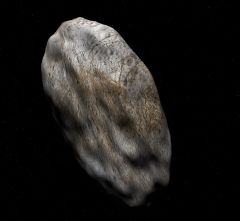Difference between revisions of "Halley"
(Comet Halley.) |
m (Arvil moved page User:Arvil/Sandbox02 to Halley: Move to article page.) |
(No difference)
| |
Revision as of 12:47, 19 July 2024
| Halley | |
|---|---|

| |
| Halley in Orbiter 2016 with D3D9 client | |
| Designation | |
| Name | Halley |
| Reference body | Sun |
| Planetary mean orbits | |
| Epoch | 2006 |
| Semimajor axis (a) | 2669601650361.16 m |
| Eccentricity (e) | 0.967449497943645 |
| Inclination (i) | 162.2922643° (2.83253436266766 radian) |
| Longitude of the ascending node (LAN, ☊) | 58.2997774° (1.01752306877974 radian) |
| Longitude of periapsis (ϖ) | 169.4792496° (2.95797092009003 radian) |
| Mean longitude (L) | 264.6340534° (4.61873554527679 radian) |
| Selected physical parameters | |
| Mean radius | 5500 km |
| Mass | 1×1014 kg |
| Rotation elements | |
| SidRotPeriod | 187200 seconds (52 hours) |
| SidRotOffset | 0 |
| Obliqutiy | 0 |
| LAN | 0 |
| Note | *Elements given are from Halley.cfg (Halley.zip) |
|
Project home: Halley's Comet Nucleus |
Halley's Comet, also referred to as 1P/Halley, is a short period comet appearing in the skies every 72 to 80 years, last seen in 1986 and the next will be in 2061. Named after Edmond Halley who was the first to recognize it as a recurring comet although it has been seen since ancient times.
Halley in Orbiter
Halley was introduced to Orbiter as an add-on in 2004. Since Orbiter was not designed to show a comet's tails, the add-on depicts it as a rugby ball shaped body much like an asteroid. Halley orbits the Sun in a very elliptical orbit, moving retrograde to the Sun, unlike the planets which move prograde, or counter-clockwise looking from the north of the Solar System. Periapsis takes Halley to between the orbits of Mercury and Venus, and at apoapsis it is beyond Pluto.
Note that when landed on Halley near the apoapsis, Halley provides only about 1% of the total gravity, the other 99% by the Sun, but, near apoapsis, Halley provides 98% of the gravity, the Sun, only about 2%. It may be difficult to stay landed near Halley's periapsis.
See also
| edit The Solar System | |
|---|---|
| Central star |
Sun (Sol) |
| Planets |
Mercury - Venus - Earth - Mars - Jupiter - Saturn - Uranus - Neptune |
| Natural satellites |
Moon - Phobos - Deimos - Io - Europa - Ganymede - Titan - more... |
| Add-ons |
Planets - Dwarf Planets - Small objects - Natural satellites - Alternative star systems |